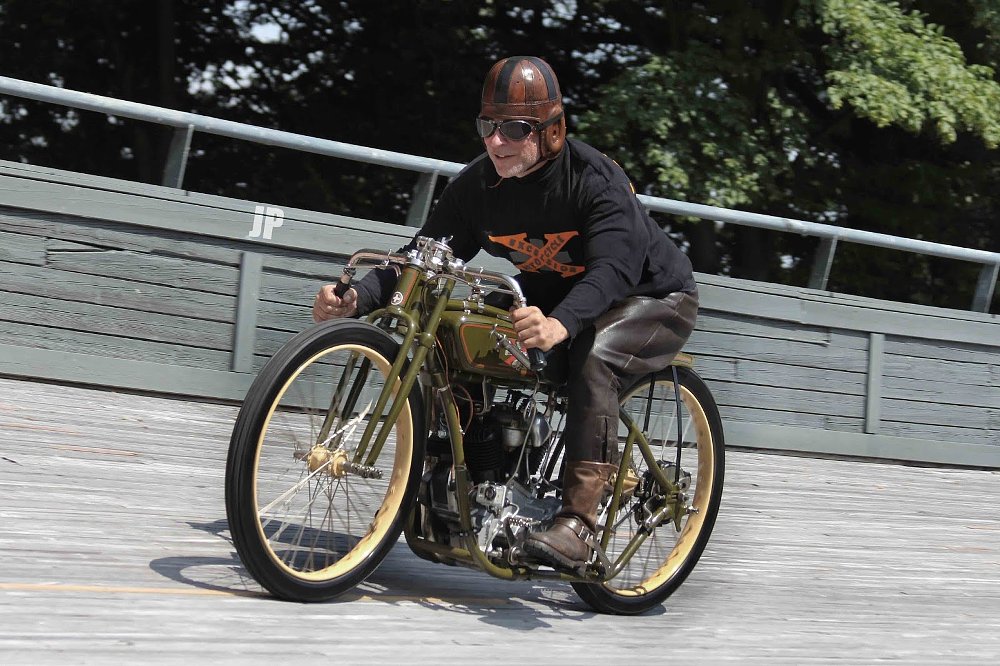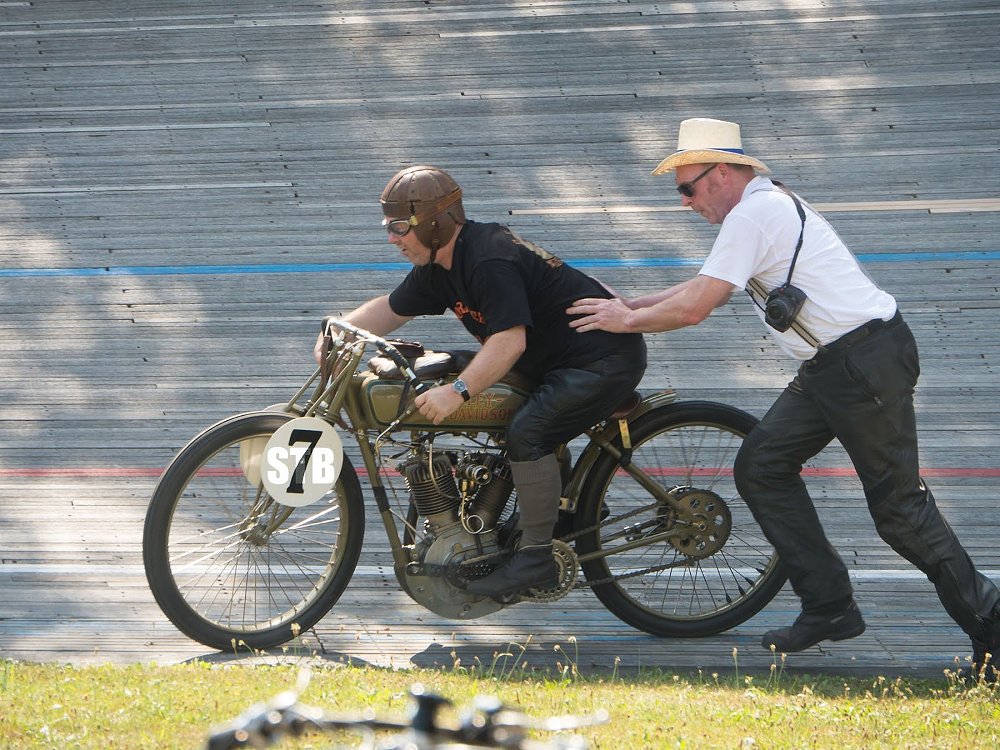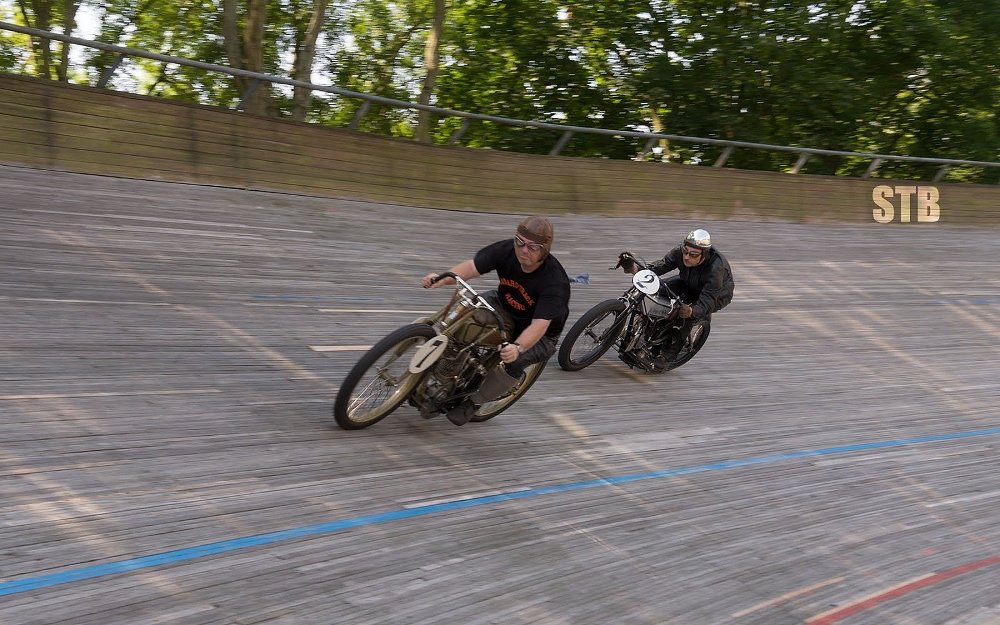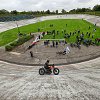The rider races around a short, steeply banked track on a skinny, antique motorcycle with no brakes. He wears a leather helmet for "protection," should he crash at 80 mph.
No, you have not been transported back to the pinnacle of motorcycle racing in the United States of the 1920s. This is today, and not even in the Americas, but in Europe. That’s where we find an unexpected revival of the popular, dangerous and otherwise extinct sport known as board-track racing.
When the board tracks ruled
The era of the board tracks was probably the most exciting and most dangerous chapter in the history of motorcycle racing.

Based on the bicycle velodromes of Europe, the first board track, or motordrome, was built in Los Angeles around 1910. It was a one-mile oval track built entirely out of wood, including the track surface, which was created using abutted two-by-four lumber with the two-inch side facing up. Racers quickly adapted their bikes to meet the specific challenges of the board tracks, developing a new breed of racing machines that could reach speeds in excess of 100 mph, had neither front nor rear brakes, and no transmissions. The only means of slowing down the motorcycles was cutting off the engine with a handlebar-mounted kill switch.
This resulted in some pretty spectacular racing and also a lot of crashes. In the event of an accident, one of two things often occurred. Either the rider was thrown from his motorcycle onto the track, which at the least resulted in a massive amount of wooden splinters from the untreated wood, or the motorcycle and rider were launched off the track into the spectators. This second type of crash resulted in the tracks getting the nickname “murderdromes,” as these crashes often resulted in death for both the rider and spectators.
These dangers, along with financial pressures brought on by the Great Depression, ultimately brought the board-track era to an end in the late 1920s.

A European board-track revival
Now fast forward about 70 years and travel across the ocean to Germany. The Hockenheimring Formula One track was putting on its annual vintage motorcycle races, called the Hockenheim Classic. Two of the participants at that event were Thomas Bund and Andreas Wehrmann. Andreas was on a 1926 Rudge 500cc single and Thomas was riding an Excelsior Super X board track racer. The two met in the pits and it soon became clear that they shared a love for racing on banked tracks like the English track at Brooklands or the French track at Montlhery. Both are modern asphalt or concrete tracks, but share design features with the historic U.S. board tracks.

They also started receiving invitations to run their motorcycles at various bicycle velodromes around Europe, which is about as close as you can get today to the original board tracks from the 1920s. Although most of these velodromes are concrete, there is an all-wood track in Hannover that really harkens back to the days of the first motordromes. The velodromes are short tracks (333 meters) with highly banked curves of about 49 degrees, so they are designed with high speeds in mind.

Vintage gear, rare race bikes
As more racers got involved, the races became a regular event at vintage racing events and invitation-only races, with a dozen to 20 riders participating. Riders strive for authenticity, both in the gear they wear and the machines they ride.

Building an authentic race bike is no easy task, either. The majority of the original race bikes were wrecked or lost by the end of the board-track era, so many of the machines being ridden today are made up of aftermarket parts built around an original engine. For example, Andreas has built a 1918 Harley-Davidson using an original 61-cubic-inch F-head motor that is mounted in a replica Keystone frame. The Keystone frame is a noteworthy early racing innovation that Harley first used in 1916. It was built by removing the bottom section of a loop frame and bolting the engine into that space with plates, making the engine a structural member. This new design lowered the overall center of gravity of the motorcycle, which dramatically improved handling.


Other bikes that regularly participate include a 1925 45-cubic-inch Excelsior Super X, a 1916 Harley-Davidson with an eight-valve V-twin, an original 1917 Harley-Davidson in a loop frame, a 1913 61-cubic-inch Indian, and an original 1913 500cc Rudge. All of these bikes are extremely rare, and some of the original machines approach six figures in value. You usually only see them in museums, not on a race track, where they belong!

Now, you can see them on track, if you go to Europe to witness the board-track revival. Might as well start checking Travelocity for flights. The flight may not be cheap, but it’s more accessible than time travel back to the 1920s. Plus after the races, I hear there are a few other things worth seeing in Europe that, surprisingly, have nothing to do with motorcycles.











